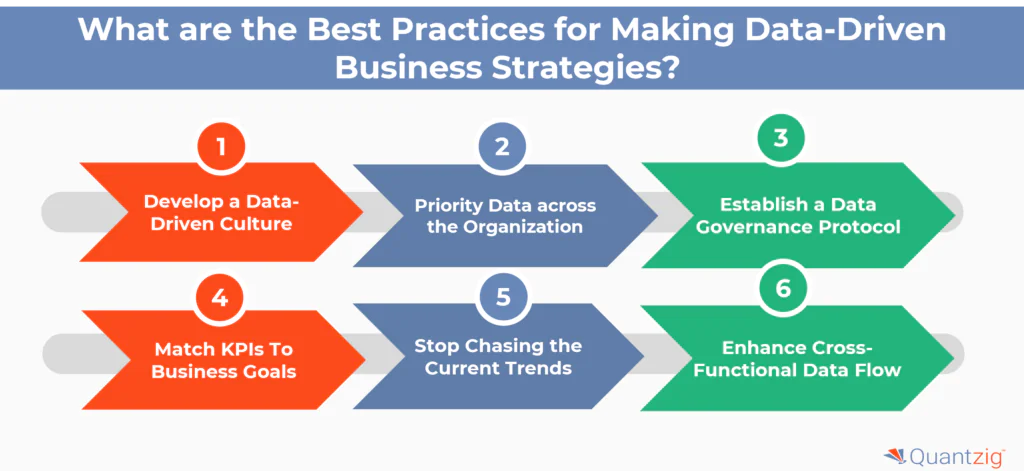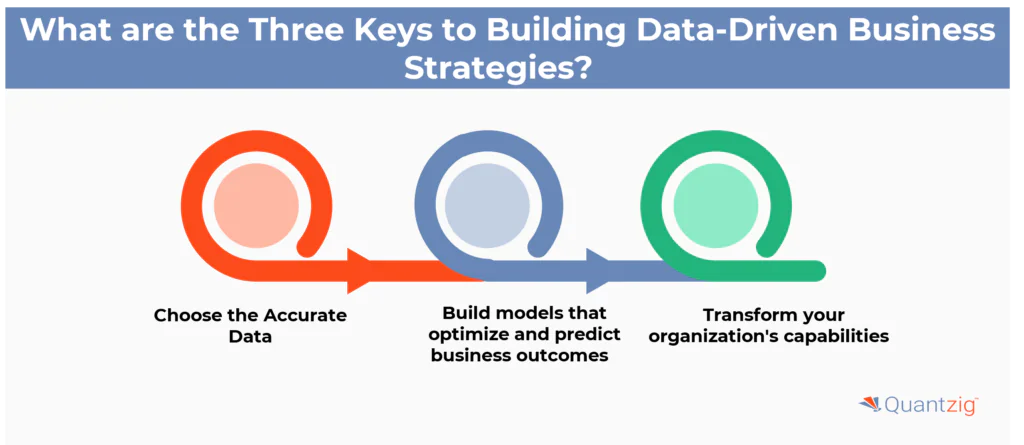Written By: Sudeshna Ghosh
Table of Contents
Key Takeaways
- Quantzig’s innovative centralized Revenue Growth Management Program helped a leading healthcare, nutrition, and personal care brand to experience a centralized data lake, a multitude of process engineering solutions (Planning, Simulation, Optimization, etc.), and intelligence layers across 15+ markets.
- In B2B enterprises, centralizing data is a complicated and expensive process that calls for a strong infrastructure and knowledgeable staff. It can also result in governance bottlenecks, long-lasting data silos, integration difficulties, and delays in standardization.
- B2B companies can reap the benefits of a Centralized Data & Analytics strategy in several ways, including better decision-making and analytics, increased data consistency and accessibility, improved security and compliance, streamlined operations and integration, and cost savings.
- Building predictive models that optimize outcomes by focusing on business opportunities, selecting accurate data to gain comprehensive business insights, and consciously shifting organizational capabilities to align with new data-driven strategies are the three keys to developing data-driven strategies.
What are Data-Driven Strategies?
Data-driven strategies are systematic approaches that leverage AI and advanced analytics tools to maximize operational effectiveness, make well-informed decisions, and foster sustainable growth. According to Quantzig experts, B2B companies that use data-driven strategies see 5-6% increases in productivity and profitability, which helps them gain a competitive edge in the dynamic market.
Introduction to Data-Driven Strategies
Nowadays, organizations have a wider range of data at their fingertips than ever before. However, a lot of B2B companies find it difficult to fully utilize it to guide their decisions and business plans. In the current market, maintaining competitiveness and enabling growth requires implementing a data-driven strategy. A company that has never used analytics before may find it intimidating to think of itself as a data-driven organization.
This article provides successful real-world examples and an explanation of what it means to use a data-driven business strategy. We’ll shed light on a case study that explores how Quantzig’s innovative centralized Revenue Growth Management Program helped a leading healthcare, nutrition, and personal care brand to experience a centralized data lake, a multitude of process engineering solutions (Planning, Simulation, Optimization, etc.) and intelligence layers across 15+ markets.
Book a demo to experience the meaningful insights we derive from data through our analytical tools and platform capabilities. Schedule a demo today!
Request a Free DemoQuantzig’s Expertise in Data-Driven Strategies for a Leading Healthcare, Nutrition, and Personal Care Brand
| Category | Details |
|---|---|
| Client Details | The client is a leading Healthcare, Nutrition, and personal care brand. |
| Challenges Faced by The Client | Complete commercial excellence became unattainable due to the difficulty of implementing localized strategies. |
| Solutions Offered by Quantzig | Quantzig implemented a centralized Revenue Growth Management (RGM) program for the client by standardizing KPIs for uniform reporting and data integration (RGM core), using low-code/no-code applications for operational problem-solving (RGMx), and providing holistic insights for informed decision-making on investments, executions, and outcomes (RGM Insights). |
| Impact Delivered | Experience a centralized data lake, a multitude of process engineering solutions (Planning, Simulation, Optimization, etc.) and intelligence layers across 15+ markets. |
Client Details
The client is a leading Healthcare, Nutrition, and personal care brand headquartered in the USA with annual revenue of $10bn+.
Challenges in Data-Driven Strategies Faced by the Client
The client implemented distributed data and analytics strategies for commercial operations, with each market implementing a customized plan to drive data and analytics. Complete commercial excellence became unattainable due to the difficulty of implementing localized strategies.
Data-Driven Strategies Offered by Quantzig for the Client
Quantzig enabled the client with a centralized Revenue Growth Management Program involving 3 levels of maturity.
- RGM core, which examined how to standardize hundreds of KPIs for uniform reporting and integrate and streamline diverse data from platforms, brands, product lines, markets, and geographic areas.
- RGMx investigated using low-code or no-code applications to power nodal solutions for operational problems, enabling business users to consume, imagine, and make informed decisions regarding various commercial operations (Pricing, Promo, Execution, Compliance, etc.).
- RGM Insights enabled the client to look at a holistic outlook and drive the right lever at the macro levels through a better understanding of investments, executions, and outcomes.
Impact Delivered using Quantzig’s Expertise
- Enabled a centralized data lake, a multitude of process engineering solutions (Planning, Simulation, Optimization, etc.), and intelligence layers across 15+ markets.
- The time to insight cycle for the globalized view of Monthly performance data was fast-tracked to first business week availability instead of 3rd business week.
Also Read: Marketing Data Management: How to Leverage Your Data
Get started with your complimentary trial today and delve into our platform without any obligations. Explore our wide range of customized, consumption driven analytical solutions services built across the analytical maturity levels.
Start your Free Trial TodayWhy is a Data-driven Business Strategy Important?
In the modern business environment, a data-driven business strategy represents a shift from isolated observations or intuition-based decisions to an effective approach where all the strategic directions are anchored on data-derived business insights. This kind of data driven transformation into the data-centric mindset is not merely about the accumulation of massive amounts of data sets. It also includes the in-depth interpretation of data to drive operational efficiency.
The genesis of data-driven business strategies is linked to the digital age. This is where the advancements in analytical tools (such as predictive analytics tool) and the ubiquity of data collection have provided immense opportunities for businesses to leverage a huge amount of data. It’s an acknowledgment that in the vast area of information, there are patterns and revelations that, when properly analyzed, can lead to better in-depth business decisions.
What are the Key Advantages of Implementing Data-Driven Strategies?
Centralized Data & Analytics strategy helps the B2B businesses with the following –
- Improved Data Consistency and Accessibility
- Enhanced Data Integrity and Quality
- Streamlined Data Integration, Operations, Orchestration, and Collaboration
- Better Security, Governance, and Compliance
- Improved Decision-Making and Analytics
- Cost Savings, Unveiling Hidden Opportunities, and Driving Efficiency
Quantzig`s data modernization strategy enables a broad spectrum / full-service data modernization program that helps many clients streamline their operations, data strategy, and time-to-insight cycles in a centralized, holistic, and future-proof way. Our process engineering and data strategy solutions enable simplified oversight for our data and analytics stakeholders through low code / no code solutions and productized tool kits at every single point of the data supply chain.
What are the Potential Challenges of Implementing Data-Driven Strategies?
Centralizing massive amounts of data from many different sources can be a complex and expensive undertaking. It demands robust data management tools, data infrastructure, and skilled personnel to handle the influx of information. Even with a centralized data management strategy, data silos might persist. Different B2B businesses follow their data collection methods and formats, making data integration a challenge. Standardizing data across the entire organization is a time-consuming process.
Besides, centralized data governance can create bottlenecks, particularly if a single team manages all data access and data analysis. This can slow down decision-making processes for other businesses waiting for data or approvals. Also, centralized teams might not have a deep understanding of specific business areas that departmental data users possess. This can lead to overlooking valuable nuances or context crucial for accurate data interpretation.
Also Read: Personalization marketing: Why it matters for your business?
Experience the advantages firsthand by testing a customized complimentary pilot designed to address your specific requirements. Pilot studies are non-committal in nature.
Request a Free PilotWhat are the Best Practices for Making Data-Driven Business Strategies?
Organizations can guarantee the successful implementation of data-driven business strategies and avoid common pitfalls by adhering to essential best practices of data-driven strategies:
- Develop a Data-Driven Culture: Promote an environment in which data is used to inform decision-making. This entails educating staff on how to evaluate data critically and apply it to support decisions.
- Set Data as a Top Priority Throughout the Organization: Information needs to be valued as a vital resource at all organizational levels. Leaders must promote the utilization of data and integrate it into all operational and strategic planning procedures.
- Establish a Data Governance Protocol: Ensuring data integrity requires data governance. Clearly define data management policies to guarantee security, accuracy, and adherence to legal requirements.
- Match KPIs To Business Goals: Establish and maintain KPIs that are in line with strategic business objectives. This consistent observation acts as a guide for both immediate and long-range plans.
- Stop Chasing the Current Trends: While new advanced technologies can be valuable, they should be adopted properly. Invest in new technologies that align with your business requirements rather than being swayed by fleeting trends.
- Enhance Cross-Functional Data Flow: Encourage cross-departmental collaboration and break down silos to make sure data is easily accessible and leveraged across the entire organization to improve overall business intelligence.
What are the Three Keys to Building Data-Driven Business Strategies?
1. Choose the Accurate Data
Over the past few years, there has been a significant shift in the data and modeling universe. The amount of data available is increasing quickly, and there are more and more opportunities to combine data to gain deeper data-derived insights. Companies can view their business environment more comprehensively and precisely due to larger and better data sets. Seeing what was previously inaccessible helps to improve strategy, operations, and customer experiences.
2. Build models that optimize and predict business outcomes
While data are necessary, analytics models that enable managers to forecast and optimize outcomes are what lead to competitive advantage and performance gains. More importantly, the best way to develop a model typically begins with identifying a business opportunity and figuring out how the model can boost performance rather than with the data. We have discovered that this type of hypothesis-led modeling generates results more quickly and grounds models in real-world data relationships that managers can comprehend more easily.
3. Transform your organization’s capabilities
Senior executives tell us that their managers’ lack of understanding and trust in big data-driven models is the main reason why they aren’t transforming their organization’s capabilities. These issues frequently result from a mismatch between an organization’s current capabilities and culture and the new strategies being developed to effectively use analytics and multiple sources of data. The new strategies either don’t fit with how businesses make decisions or don’t offer a clear road map for achieving objectives.
Tools appear to be made for modeling experts rather than for practitioners, and managers don’t seem to find the models interesting enough to support their use, which is a major flaw if businesses want the new techniques to become ingrained in the company. In summary, utilizing big data necessitates deliberate organizational change.
Conclusion
For businesses of all shapes and sizes, a data-driven business strategy can have revolutionary effects. By utilizing analytics and data-derived insights from operational, market, and customer data, your business can maximize productivity, enhance innovation, and establish a competitive edge. Although adopting a data-focused approach necessitates dedication and investment, it’s a wise move for futureproofing your company due to its long-term benefits.






